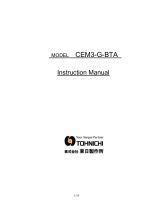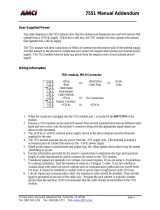
Sensors Worldwide
™
BTL5-P/I/K/L/M_-M/U_ _ _ _-P-S 32/KA_ _
Micropulse Linear Transducer
Digital Output / Profile Housing
Technical Description / User’s Guide


28 0711
30 0762
32 0813
36 0914
40 1016
inches mm
15 0381
16 0407
18 0457
20 0508
22 0560
24 0610
26 0661
Rugged,
Compact
Rod Style
Compact,
bolt-in
Rod Style
Rod Style
Explosion-proof
Rod Style
Balluff - Linear Transducer
Generation 5
Output Type
Supply Voltage
1 = 24 Vdc ±20%
2 = ±15 Vdc ±2%
Normal Stroke Length
Housing Type
P = Standard Profile Housing
Connection Type
S 3 2
K A 0 5
= 8-pin quick disconnect metal connector
= Cable out (5m standard; specify length in meters)
Differential start/stop with tri-state
Differential stop - leading edge active
Differential pulse-width modulated
Differential start/stop - leading edge active
Single ended start/stop - leading edge active
Differential start/stop - trailing edge active
I
K
L
M
N
P
=
=
=
=
=
=
K A 0 5
0 3 0 5 = 305mm active stroke
1 2 3 4 5 6 7 8 9 10 11 12 13 14 15 16 17 18 19 20 21 22
B T L - 5 - P 1 - M 0 3 0 5 - P - S 3 2
Standard Stroke Lengths (consult factory for additional lengths)
inches mm
148 3759
156 3962
Electrical Stroke
inches mm
2 0051
3 0077
4 0102
5 0127
6 0152
7 0178
8 0203
9 0230
10 0254
11 0280
12 0305
13 0330
inches mm
42 1067
48 1220
50 1270
60 1524
70 1778
80 2032
90 2286
100 2540
110 2794
120 3048
130 3302
142 3606

BTL5-P/I/K/L/M_-M/U_ _ _ _-P-S32/KA_ _
Micropulse Linear Transducer
Digital Output / Profile Housing
Read this manual before installing and operating the Micropulse
Transducer.
1.1 Proper application
The BTL5 Micropulse transducer is intended to be installed in a
machine or system. Together with a controller (PLC) or a proces-
sor (BTA) it comprises a position measuring system and may only
be used for this purpose.
Unauthorized modifications and non-permitted usage will result in
the loss of warranty and liability claims.
1.2 Qualified personnel
This guide is intended for specialized personnel who will perform
the installation and setup of the system.
1.3 Use and inspection
The relevant safety regulations must be followed when using the
transducer system. In particular, steps must be taken to ensure
that should the transducer system become defective no hazards to
persons or property can result. This includes the installation of
additional safety limit switches, emergency shutoff switches and
maintaining the permissible ambient conditions.
1.4 Scope
This guide applies to the model
BTL5-P/I/K/L/M...P... Micropulse
transducer.
An overview of the various models
can be found in section 6 Versions
(indicated on product label)
on page 7.
1 Safety Advisory
Contents
1 Safety Advisory ............... 2
1.1 Proper application .............. 2
1.2 Qualified personnel ............ 2
1.3 Use and inspection ............ 2
1.4 Scope ................................ 2
2 Function and
Characteristics ............... 3
2.1 Characteristics .................. 3
2.2 Function ............................. 3
2.3 Available stroke lengths
and magnets ..................... 3
3 Installation ..................... 3
3.1 Transducer installation ...... 3
3.2 Floating magnets ............... 4
3.3 Captive magnets ............... 5
4 Wiring .............................. 6
5 Startup ............................. 7
5.1 Check connections ........... 7
5.2 Turning on the system ....... 7
5.3 Check output values ......... 7
5.4 Check functionality ............ 7
5.5 Fault conditions ................. 7
5.6 Noise elimination ............... 7
6 Versions
(indicated on part label) 7
7 Technical Data ............... 8
7.1 Dimensions, weights,
ambient conditions ............ 8
7.2 Supply voltage (external) .... 8
7.3 Control signals .................. 8
7.4 Connection to processor ... 8
7.5 Included in shipment ......... 8
7.6 Magnets (order separately) 8
7.7 Accessories (optional) ....... 8
7.8 Compatible processors
and displays ...................... 8
Note: For special versions,
which are indicated by an -
SU_ _ _ designation in the
part number, other technical
data may apply (affecting
calibration, wiring, dimen-
sions etc.).
Group 1, Class A
Noise immunity tests:
Static electricity (ESD)
EN 61000-4-2
Severity level 3
Electromagnetic fields (RFI)
EN 61000-4-3
Severity level 3
Fast transients (Burst)
EN 61000-4-4
Severity level 3
Surge
EN 61000-4-5
Severity level 2
Line-induced noise induced by
high-frequency fields
EN 61000-4-6
Severity level 3
Magnetic fields
EN 61000-4-8
Severity level 4
The CE Mark verifies that
our products meet the
requirements of
EC Directive
89/336/EEC (EMC Directive)
and the EMC Law. Testing in our
EMC Laboratory, which is accredited
by DATech for Testing Electromag-
netic Compatibility, has confirmed
that Balluff products meet the EMC
requirements of the following
Generic Standards:
EN 50081-2 (emission)
EN 61000-6-2 (noise immunity)
Emission tests:
RF Emission
EN 55011
The following patents
have been granted in
connection with this
product:
US Patent 5 923 164
Apparatus and Method for
Automatically Tuning the
Gain of an Amplifier
US Patent 5 903 426
Overvoltage Protection
Apparatus for Data
Interface

WWW.BALLUFF.COM • 1-800-543-8390
BTL5-P/I/K/L/M_-M/U_ _ _ _-P-S32/KA_ _
Micropulse Linear Transducer
Digital Output / Profile Housing
2 Function and Characteristics
2.1 Characteristics
Micropulse transducers feature:
—Very high resolution,
repeatability and linearity
—Bus-compatible interface
(BTL5-I...)
— Immunity to shock, vibration,
contamination and electrical
noise
—An absolute output signal
—BTL to processor cable
lengths up to 500 m
—IP 67 per IEC 529
2.2 Function
The Micropulse transducer
contains a tubular waveguide
enclosed by an extruded
aluminum housing. A magnet
attached to the moving member
of the machine is moved across
the top of the housing and its
position constantly updated.
The magnet defines the
measured position on the
waveguide. An externally
generated INIT pulse interacts
with the magnetic field of the
magnet to generate a magneto-
strictive torsional wave in the
waveguide which propagates at
ultrasonic speed.
The torsional wave arriving at the
end of the waveguide is absorbed
in the damping zone. The wave
arriving at the beginning of the
waveguide creates an electrical
signal in the coil surrounding the
waveguide. The propagation time
of the wave is used to determine
the position, which is presented
on the output in various digital
formats. This takes place with
high precision and repeatability
within the measuring range
indicated as the nominal
stroke length.
On both ends of the nominal
stroke length is an area which
provides an unreliable signal, but
which may be entered.
The electrical connection between
the transducer, the processor/
controller and the power supply is
via a cable, which depending on
the version is either fixed or
connected using a female
connector.
Dimensions for installing the
Micropulse transducer and for the
magnets and control arm are
found on pages 4 and 5.
2.3 Available stroke length
To provide for optimum fit in any
application, a wide range of
standard stroke lengths and
magnets in various form factors
are available. Magnets and control
arms must therefore be ordered
separately.
See inside front cover for
available stroke lengths.
3.1 Transducer installation
Ensure that no strong
electrical or magnetic fields
are present in the
immediate vicinity of the
transducer.
Any orientation is permitted.
The mounting brackets and
cylinder head screws allow the
transducer to be mounted on a
flat machine surface. These
should be evenly spaced (Figs.
3-1 and 3-5). The recom-
mended spacing for long
transducers and extreme
conditions (e.g. strong shock or
vibration):
A = 80 mm; spacing between
the individual brackets
B = 250 mm.
The isolation bushings are used
to electrically insulate the
transducer from the machine
(Fig. 3-1and 3-5 and chapter 5.6
Noise elimination).
The Micropulse transducer in
profile housing is suitable both
for floating, i.e. non-contacting
magnets (Page 4) and for
captive magnets (Page 5).
3 Installation
Notch on housing to mark the beginning of the stroke range
Current position of magnet
Micropulse Transducer
Nominal stroke =
Measuring range
Fig. 2-1: Basic arrangement
El. connection
Damping zone
Moving machine
part
and magnets

1-800-543-8390 • WWW.BALLUFF.COM
BTL5-P/I/K/L/M_-M/U_ _ _ _-P-S32/KA_ _
Micropulse Linear Transducer
Digital Output / Profile Housing
3 Installation (cont.)
Fig. 3-1: Dimensional drawing (BTL5...P-S 32 transducer with floating magnet BTL5-P-3800-2)
NL
Nominal stroke
Mounting brackets with isolation bushings and M5 x 22
cylinder head screws, DIN 912, max. tightening torque 2
Nm
55
28
45
21
Ø 4.2
20
61 +10
1
15
E
E
C
D
Fig. 3-2: BTL5-P-3800-2 magnet Fig. 3-4: BTL5-P-4500-1
electromagnet (24 V/100 mA)
Fig. 3-3: BTL5-P-5500-2 magnet
max. permissible
tightening torque 2 Nm
3.2 Floating magnets
The floating magnet (Figs. 3-2
to 3-4) is attached to the
moving member of the machine
using non-magnetizable screws
(brass, aluminum). To ensure
the accuracy of the transducer
system, the moving member
must carry the magnet on a
track parallel to the transducer.
The following table provides
figures in [mm] for the spacing
which must be maintained
between magnet and transducer
and for the permissible center
offset:
Magnet type Distance
" D " Offset
" C "
BTL5-P-3800-2 0.1 ... 4 ± 2
BTL5-P-5500-2 5 ... 15 ± 15
BTL5-P-4500-1 0.1 ... 2 ± 2
BTL5-P-4500-1 magnet,
special features: Multiple
magnets on the same
transducer can be turned on
and off individually (PLC control
signal).
The stroke range is offset 4
mm towards the BTL
connector/cable (Fig. 3-4).
Ensure that the
distance E between
parts made of
magnetizable
material and the
BTL5-P-5500-2 magnet is at
least 12 mm (Fig. 3-3).

WWW.BALLUFF.COM • 1-800-543-8390
BTL5-P/I/K/L/M_-M/U_ _ _ _-P-S32/KA_ _
Micropulse Linear Transducer
Digital Output / Profile Housing
3 Installation (cont.)
Fig. 3-5: Dimensional drawing (BTL5...P-KA transducer with captive magnet BTL5-F-2814-1S)
Mounting brackets with isolation bushings and M5 x 22
cylinder head screws, DIN 912,
max. tightening torque 2 Nm
Black,
round
marking
NL
Nominal stroke
Ball joint "B"
DIN 71805,
rotates horizontally
Black, round
marking
Fig. 3-6: BTL5-F-2814-1S magnet
Fig. 3-7: BTL5-M/N-2814-1S magnet
Mechanically joined to M5
stud using 2 nuts Max. angle offset
Max. parallel offset
BTL5-M-2814-1S: X = 48.5 Y = 57
BTL5-N-2814-1S: X = 51 Y = 59.5
3.3 Captive magnets
Lateral forces are to be avoided
when using captive magnets
(Figs. 3-6 and 3-7). Connections
are required here which permit the
corresponding degree of freedom
with respect to the direction of
movement of the magnet along
the stroke range. It is assumed
that the BTL5-F-2814-1S magnet
is connected to the machine
member using a connecting rod.
The BTL2-GS08...A connecting
rod (Fig. 3-8) is available as an
accessory (please indicate length
LS when ordering).
Jam nut DIN 934 M5
Swivel eye DIN 648
Ball joint "B" DIN 71805,
rotates horizontally (part of
BTL5-F-2814-1S) magnet)
Fig. 3-8: BTL2-GS08-_ _ _ _-A
connecting rod

1-800-543-8390 • WWW.BALLUFF.COM
BTL5-P/I/K/L/M_-M/U_ _ _ _-P-S32/KA_ _
Micropulse Linear Transducer
Digital Output / Profile Housing
4 Wiring
straignt
BKS-S 32M-00
right-angle
BKS-S 33M-00
Cable entry
(PG 9 fitting)
Note the following
when making
electrical connec-
tions:
System and control cabinet
must be at the same
ground potential.
To ensure the electromagnetic
compatibility (EMC) which
Balluff warrants with the CE
Mark, the following instruc-
tions must be strictly
followed.
BTL transducer and the
processor/control must be
connected using
shielded cable.
Shielding: Copper filament
braided, 80% coverage.
The shield must be tied to the
connector housing in the
BKS connector (Fig. 4-1); see
instructions accompanying
the connector.
In the cable version the cable
shield is connected to the
housing in the PG fitting.
The cable shield must be
grounded on the control side,
i.e., connected to the
protection ground.
Pin assignments can be
found in Table 4-1. Connec-
tions on the controller side
may vary according to the
controller and configuration
used.
When routing the cable between
the transducer, controller and
power supply, avoid proximity to
high voltage lines to prevent noise
coupling.
Especially critical is inductive
noise caused by AC harmonics
(e.g. from phase-control devices),
against which the cable shield
provides only limited protection.
Cable length max. 500 m ;
Ø 6 to 8 mm.
High noise immunity on the line
between the transducer and
processor is provided by the
differential line drivers used for
the RS 485/422 interface. The
differential signal is carried to the
processor, which makes it
available as analog or digital
information for
further processing.
Fig. 4-1: Connector (optional)
1YE
3PK
Interrogate + Input
Interrogate - Input
2GY
5GN
Pulse + Output
Pulse - Output
7BN
6BU
+24 V
GND
Digital, RS485 differential
24 V (P, M, I, K, L, R)
8WH GND
0117a025
1
2
3
4
5
6
7
8
View of mating
connector, wiring side
1YE Interrogate + Input
2GY Pulse + Output
7BN
6BU
+24 V
GND
Digital, Single-ended
24 V (N)
8WH GND
0117a026
1YE
3PK
Interrogate + Input
Interrogate - Input
2GY
5GN
Pulse + Output
Pulse - Output
7BN
6BU
+15 V
GND
Digital, RS485 differential
±15 V (P, M, I, K, L, R)
8WH -15 V
0117a027
1YE Interrogate + Input
2GY Pulse + Output
7BN
6BU
+15 V
GND
Digital, Single-ended
±15 V (N)
8WH - 15 V
0117a028
Fig. 4-2: Pin assignments BKS,
connector type BTL
BKS connector,
view towards
solder side of
female BKS-S
32M-00 or BKS-S
33M-00

WWW.BALLUFF.COM • 1-800-543-8390
BTL5-P/I/K/L/M_-M/U_ _ _ _-P-S32/KA_ _
Micropulse Linear Transducer
Digital Output / Profile Housing
4 Wiring (cont.)
INIT
START/STOP
INIT
START/STOP
GND
+24 V
YE
GY
PK
GN
BU
BN
BTL5-P1...KA_ _
processor or
controller
Fig. 4-3: BTL5-P1...KA_ _ with processor controller, wiring example
5 Startup
5.1 Check connections
Although the connections are
polarity reversal protected,
components can be damaged
by improper connections and
overvoltage. Before you apply
power, check the connec-
tions carefully.
5.2 Turning on the system
Note that the system may
execute uncontrolled move-
ments when first turned on or
when the transducer is part of a
closed-loop system whose
parameters have not yet been
set. Therefore make sure that
no hazards could result from
these situations.
5.3 Check output values
After replacing or repairing a
transducer, it is advisable to verify
the values for the start and end
position of the magnet in manual
mode. If values other* than those
present before the replacement or
repair are found, a correction should
be made.
* Transducers are subject to
modification or manufacturing
tolerances.
5.4 Check functionality
The functionality of the transducer
system and all its associated
components should be regularly
checked and recorded.
5.5 Fault conditions
When there is evidence that the
transducer system is not
operating properly, it should be
taken out of service and
guarded against unauthor-
ized use.
5.6 Noise elimination
Any difference in potential -
current flow - through the cable
shield should be avoided.
Therefore:
– Use the isolation bushings,
and
– Make sure the control
cabinet and the system in
which the BTL5 is contained
are at the same
ground potential.
Micropulse
Linear Transducer
6 Versions (indicated on part label)
Supply voltage 1 = DC 24 V, 2 = DC ±15 V
Electr. connect., S32: with connector,
BTL5-P1-M0450-P-S32 KA05: with 5 m cable
Profile form factor
Nominal stroke (4 digits): M = Metric units [mm]
U = Inch units [1/10 in.]
Digital output signals: BTL5-N... BTL5-P... BTL5-M... BTL5-I... BTL5-K... BTL5-L...
Start Stop Start Stop Start Stop Start Stop Stop Gate
(Trailing Edge
Active)
(Leading Edge
Active)
(RS-485
Multiplex)
(Leading Edge
Active)
(Pulse-width-
Modulated)
Single Ended

1-800-543-8390 • WWW.BALLUFF.COM
BTL5-P/I/K/L/M_-M/U_ _ _ _-P-S32/KA_ _
Micropulse Linear Transducer
Digital Output / Profile Housing
7 Technical Data
The following are typical values at DC 24 V and 25 °C. Fully operational after power-up, with full accuracy after
warm-up. Values are with BTL5-P-3800-2, BTL5-P-4500-1 or BTL5-P-5500-2 magnet held at a constant
offset from the transducer or with captive magnet BTL5-F/M/N-2814-1S (see magnet section for exceptions):
Resolution < 2 µm
Hysteresis < 4 µm
Repeatability < 6 µm
(resolution + hysteresis)
System resolution (BTL5-.... + BTA)
is determined by the processor or
external controller.
Recommended sampling rate:
Nominal length fStandard
< 1000 mm 0.5 to 2 kHz
< 2000 mm 0.5 to 1 kHz
> 2000 mm 0.5 kHz
Non-linearity:
Nom. length < 500 mm > 500 mm
±100 µm ±0.02 %
Temperature coefficient
< (6 µm + 5 ppm * nominal length)/K
Shock loading 100 g/6 ms
per IEC 68-2-27 1
Continuous shock 100 g/2 ms
per IEC 68-2-29 1
Vibration 12 g, 10 to 2000 Hz
per IEC 68-2-6 1
1Individual specifications as per
Balluff factory standard
7.1 Dimensions, weights, ambient
conditions
• Nominal length < 4000 mm
• Dimensions pages 4 and 5
• Weight approx. 1.4 kg/m
• Housing anodized aluminum
• Housing attachment:
Mounting clamps with isolation
bushings and screws
• Operating temp. –40 °C to +85 °C
• Humidity < 90%, non-condensing
• Protection class per IEC 529 IP 67
when closed up
7.2 Supply voltage (external)
Regulated supply voltage
BTL5-_1... DC 20 to 28 V
Ripple < 0.5 Vpp
BTL5-_2... DC ±14.7 to ±15.3 V
Current draw < 90 mA (at 1 kHz)
Inrush < 3 A/0.5 ms
Polarity reversal protection built-in
Overvoltage protection
Transzorb diodes
Electric strength
GND to housing 500 V
Control arm (optional)
BTL2-GS08-_ _ _ _-A
Aluminum, dimensions
Fig. 3-
8
Various standard lengths LS
available (please specify when
ordering)
7.7 Accessories (optional)
Connectors Fig. 4-1
7.8 Compatible processors and
... for BTL5-P1
Analog output processor cards:
BTA-A 0...10 and 10...0 V
BTA-C 0...20 or 20...0 mA *
BTA-E 4...20 or 20...4 mA *
BTA-G -10...10 and 10...-10 V
* also: 0...10 V and 10...0 V
Digital output processor cards:
BTA-D11 20 bit, binary
BTA-S11 16 setpoint outputs
BTA-H11 22 bit,
BCD, Gray/binary or
SSD, Gray
BTA-V11 Velocity output card
Parallel, digital and analog output
Displays:
BDD-07-9 digital display, 7-digit
for BTA-H, BTA-S and BTA-V
BDD-AM10-1-P display and
controller with 2 relay outputs
BDD-CC08-1-P display and
controller with 8 setpoints
7.3 Control signals
INIT pulse
Level +5 V RS 485/422 driver
Length 1 µs (max. 3 µs)
Pulse lengths over 3 µs
can damage the unit.
Shielded cable,
max. length 500 m, Ø 6 to 8 mm.
7.5 Included in shipment
Transducer Fig. 3-1
or Fig. 3-5
(with mounting brackets,
isolation bushings and screws,
not incl. magnet)
7.6 Magnets (order separately)
• Spacing, offset and installation
pages 4 and 5
Operating temp. –40 °C to +85 °C
BTL5-P-3800-2 Fig. 3-2
Weight approx. 12 g
Housing plastic
BTL5-P-5500-2 Fig. 3-3
Weight ca. 40 g
Housing plastic
Non-linearity:
Nom. length < 500 mm > 500 mm
±150 µm ±0.03 % FS
BTL5-P-4500-1 Fig. 3-4
Weight approx. 90 g
Housing plastic
Operating temp. –40 °C to +60 °C
BTL5-F-2814-1S Fig. 3-6
Weight approx. 28 g
Housing plastic
BTL5-M-2814-1S Fig. 3-7
Weight approx. 32 g
Housing anodized
aluminum
Contact surface plastic
BTL5-N-2814-1S Fig. 3-7
Weight approx. 35 g
Housing anodized
aluminum
Contact surface plastic
7.4 Connection to processor
displays

WWW.BALLUFF.COM • 1-800-543-8390
BTL5-P/I/K/L/M_-M/U_ _ _ _-P-S32/KA_ _
Micropulse Linear Transducer
Digital Output / Profile Housing
7 Magnet and Control Arm Diagram Refernces
55
28
45
21
Ø 4.2
20
61 +10
1
15
E
E
C
D
Fig. 3-1: Dimensional
drawing (BTL5...P-S 32
transducer with floating
magnet BTL5-P-3800-2)
NL
Nominal stroke
Mounting brackets with isolation bushings and M5 x 22 cylinder
head screws, DIN 912, max. tightening torque 2 Nm
Fig. 3-5: Dimensional
drawing (BTL5...P-KA
transducer with captive
magnet BTL5-F-2814-
1S)
Mounting brackets with isolation bushings and M5 x 22 cylinder head
screws, DIN 912, max. tightening torque 2 Nm
NL
Nominal stroke
Fig. 3-2: BTL5-P-3800-2 magnet Fig. 3-4: BTL5-P-4500-1
electromagnet (24 V/100 mA)
Fig. 3-3: BTL5-P-5500-2 magnet
max. permissible
tightening torque 2 Nm
Ball joint "B"
DIN 71805,
rotates horizontally
Black, round
marking
Fig. 3-6: BTL5-F-2814-1S magnet Fig. 3-7: BTL5-M/N-2814-1S magnet
Mechanically joined to M5
stud using 2 nuts
Max. angle offset
Max. parallel offset
BTL5-M-2814-1S: X = 48.5 Y = 57
BTL5-N-2814-1S: X = 51 Y = 59.5
straignt
BKS-S 32M-00
right-angle
BKS-S 33M-00
Cable entry
(PG 9 fitting)
Fig. 4-1: Connector (optional)
Jam nut DIN 934 M5
Swivel eye DIN 648
Ball joint "B" DIN 71805,
rotates horizontally (part of
BTL5-F-2814-1S) magnet)
Fig. 3-8: BTL2-GS08-_ _ _ _-A
connecting rod

www.balluff.com
Sensors Worldwide Technical Description / User’s Guide
Inductive
Sensors
Connectors &
Accessories
Photoelectric
Sensors Micropulse
TM
Transducers
Electromechanical
Sensors
Magnetic Field
Sensors
Identification
Systems
Capacitive
Sensors
Germany
Global Headquarters
Balluff GmbH
Schurwaldstraße 9
73765 Neuhausen a.d.F.
Telefon: +49 (0)71 58/1 73-0
Telefax: +49 (0)71 58/50 10
Hotline: +49 (0)71 58/1 73-370
Web: www.balluff.de
E-mail: [email protected]
USA
North American Headquarters
Balluff Inc.
8125 Holton Drive
Florence, KY 41042
Phone: (859) 727-2200
Toll-free: 1-800-543-8390
Fax: (859) 727-4823
Web: www.balluff.com
E-Mail: [email protected]
Canada
Balluff Canada, Inc.
2840 Argentia Road, Unit #2
Mississauga, Ontario L5N 8G4
Phone: (905) 816-1494
Toll-free: 1-800-927-9654
Fax: (905) 816-1411
Web: www.balluff.ca
E-mail: [email protected]
Mexico
Balluff de Mexico S.A. de C.V
Prol. Av. Luis M. Vega #109
Col. Ampliacion Cimatario
Queretaro, QRO 76030
Phone: (++52 442) 212-4882,
224-3583, 224-3171
Fax: (++52 442) 214-0536
E-mail: [email protected]
Complete Product Range
Doc. no. 883599/Mat. no. 317097 • Edition 0308 ; Subject to Modification
-
 1
1
-
 2
2
-
 3
3
-
 4
4
-
 5
5
-
 6
6
-
 7
7
-
 8
8
-
 9
9
-
 10
10
-
 11
11
-
 12
12
Balluff BTL5-M-M User manual
- Type
- User manual
- This manual is also suitable for
Ask a question and I''ll find the answer in the document
Finding information in a document is now easier with AI
Related papers
-
Balluff BVS HS-PB Quick Manual
-
Balluff BML-S2C0-Q-M6-0-KA Series Condensed Manual
-
Balluff BML-S1G0-S7FD-M5EZ-90-S284 Condensed Manual
-
Balluff BNI IOL-802-000-Z036 User manual
-
Balluff BNI IOL-719-002-Z012 User manual
-
Balluff BAM PC-OS-024-23K-1 User manual
-
Balluff BMP 01-ZLZPP21A-0256-00-P00,5-S4 User manual
-
Balluff BNI007Z User manual
-
Balluff BIS C-6002 User manual
-
Balluff BFS000M Interface Description
Other documents
-
Gnet G888 Hard reset manual
-
Analog Devices MAXREFDES36# Operating instructions
-
 Tohnichi CEM3-G-BTA Owner's manual
Tohnichi CEM3-G-BTA Owner's manual
-
Cardo Scala-500 Combo Owner's manual
-
 Texmate TD5300 Owner's manual
Texmate TD5300 Owner's manual
-
 Profile Design HSF Aerodrink BTA Tilt Bracket Operating instructions
Profile Design HSF Aerodrink BTA Tilt Bracket Operating instructions
-
Delta RMC70 Startup Manual
-
 Profile Design HSF BTA Drink System Tilt Wedges Operating instructions
Profile Design HSF BTA Drink System Tilt Wedges Operating instructions
-
MTS Systems Temposonics RP5-M-A Operating instructions
-
 AMCI 7551 Manual Addendum
AMCI 7551 Manual Addendum
















